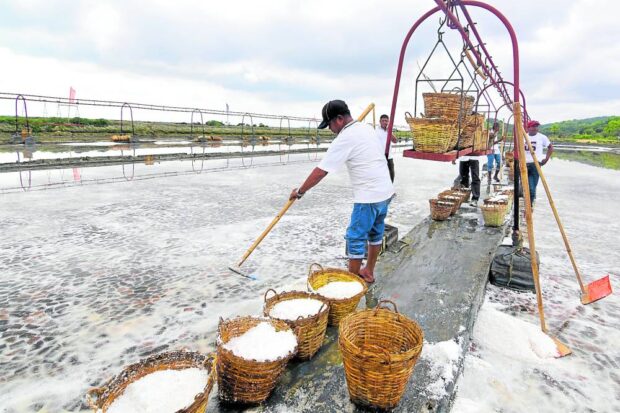In Pangasinan, revived salt farm seen to rescue industry

BOUNTIFUL HARVEST A farmworker harvests salt at the newly rehabilitated 473-hectare Pangasinan Salt Center at Barangay Zaragoza in Bolinao during the ceremonial harvest on Dec. 21. —WILLIE LOMIBAO
BOLINAO, PANGASINAN — Val Maguate, 34, could not help but feel ecstatic as he harvested salt from plastic-lined salt beds in the coastal farm at Barangay Zaragoza in this town.
“This is the work I know, the work I did for nine years, and I am overjoyed that I am doing it again full time,” villager Maguate told the Inquirer in a recent interview.
He is one of the 70 workers who have been hired by the provincial government to work at the 473-hectare salt farm that used to be privately operated but was closed in February 2021 by the Department of Environment and Natural Resources (DENR) after its foreshore lease agreement expired in 2002.
After almost two years of being idle, the sprawling farm began churning salt again, giving a much-needed shot in the arm to the country’s ailing salt industry.
The provincial government has taken over the operations of the farm after it entered into a memorandum of agreement (MOA) with the DENR in December last year.
Article continues after this advertisementSalt farm workers, led by assistant provincial agriculture officer Nestor Batalla, buckled down to work by October this year. They cleaned the salt beds and prepared them for salt-making activities.
Article continues after this advertisementBy December, the vast salt beds were already sparkling with the white mineral and ready for harvesting.
READ: Future looks bland for land of salt
Ceremonial harvest
On Dec. 21, the ceremonial harvesting of salt was led by national, provincial, and local officials and the residents who have been waiting for the farm to operate once more.
Gov. Ramon Guico III said the reopening of the salt farm, which has been renamed Pangasinan Salt Center (PSC), is one of the activities that would reestablish the province as the country’s top producer of solar salt.
He also hoped that it would help minimize the country’s dependence on imported salt, which is 93 percent of the country’s need and equivalent to 550,000 metric tons.
The farm’s closure set back the country’s production by 25,000 MT annually. But what was lost is about to be regained through the MOA that gave the provincial government the right to operate the farm.
“The word salt is attached to the identity of Pangasinan, which literally means where salt is made. Our province is blessed with two resources that make it conducive to producing salt: sun and coastal areas,” Guico said in a speech.
He added: “We have to use these resources to produce this important mineral.”
The salt farm could also generate income through tourism activities, Guico said.
Vice Gov. Mark Lambino said the salt farm would bring income to the province as well as create employment opportunities for the residents.
“Asindero” (farm managers) are committed to producing 20,000 MT to 30,000 MT of salt every year, cementing the province’s legacy as a salt producer in the country, Lambino said.
READ: Salt industry in crisis: Villar fuming over DENR exec invoking Land Use Act
Stamp
“It is easier to import mined salt, but we are a coastal province, and it’s time we put a stamp on it and establish our brand of salt, and hopefully we will export it in the future,” he added. Through solar evaporation, a square meter of salt bed could produce a kilo of “barara” (rock salt) that could be sold for P5 to P6.
Solar evaporation does away with the traditional “banigan” (salt beds), which need large spaces and are expensive to construct and maintain.
Saltmaker Edwin Tolete, 48, said the simple technology could help the fisherfolk and coastal residents contribute to salt production, even if they do not have fishponds that are used as salt beds during the summer.
The reopening of the salt farm also meant job opportunities for the workers displaced by the farm’s closure in 2021.
Felizardo Camero Jr., 50, an employee of Pacific Farms Inc. that used to operate the farm, said the company retained only 30 workers, including him, out of 250 workers. He retired from the company to work with the PSC.
Batalla said with the takeover by the provincial government, at least 70 workers were hired, and more would be employed when the farm expands operations in the coming years.
The former workers are the priority in the hiring.
But the operation this year is only “experimental,” and the MOA between the DENR and the provincial government would be renewed if the experiment is successful, the local officials said.
The MOA is set to be renewed in 2024, and eventually, there could be an infusion of funds from the Department of Agriculture-Bureau of Fisheries and Aquatic Resources, which is tasked with developing and revitalizing the country’s salt industry.